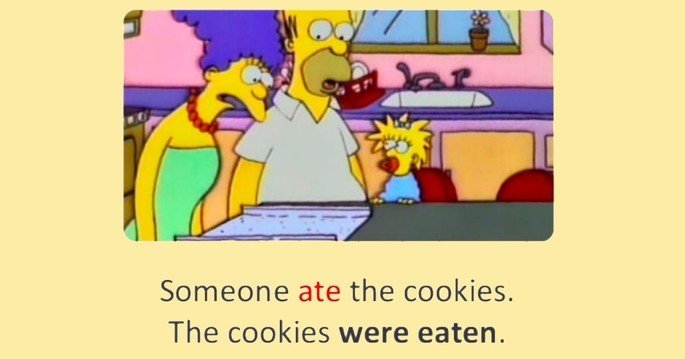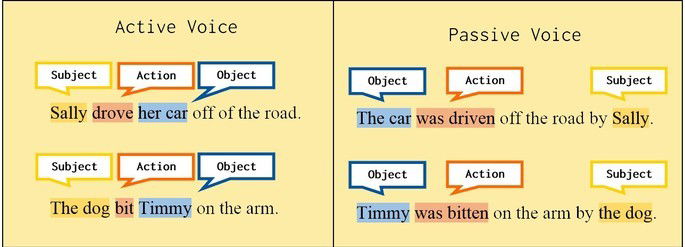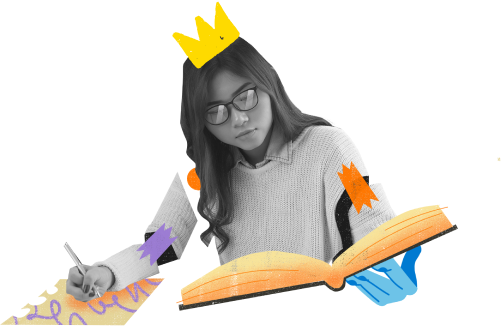Passive Voice
A passive voice (voz passiva) é um tipo de construção frasal onde o sujeito é paciente, ou seja, sofre a ação da frase em vez de praticá-la. É destacado o que acontece com o sujeito, porém, sem enfatizá-lo.
Exemplo: The car was washed. (O carro foi lavado.)
O foco do exemplo acima é o objeto do período (the car), uma vez que ele recebe a ação de ser lavado.
Regras e exemplos de uso da passive voice
A voz passiva pode ser utilizada em frases afirmativas, negativas e interrogativas. Sua formação é expressa por:
Objeto + verbo to be + Past Participle (Particípio passado) do verbo principal + complemento
Essa estrutura pode ser utilizada em diversos tempos verbais do presente, do passado e do futuro. Para isso, basta flexionar o verbo to be.
Confira abaixo alguns exemplos:
Passive voice no Simple Present
Objeto + am/is/are + Past Participle (Particípio passado) do verbo principal + complemento
Exemplos:
- Affirmative Form: The school is painted by John. (A escola é pintada pelo John.)
- Negative Form: The school isn’t painted by John. (A escola não é pintada pelo John.)
- Interrogative Form: Is the school painted by Jonh? (A escola é pintada pelo John?)
Passive voice no Present Continuous
Objeto + am being/is being/are being + Past Participle (Particípio passado) do verbo principal + complemento
Exemplos:
- Affirmative Form: The school is being painted by John. (A escola está sendo pintada pelo John.)
- Negative Form: The school isn’t being painted by John. (A escola não está sendo pintada pelo John.)
- Interrogative Form: Is the school being painted by John? (A escola está sendo pintada pelo John?)
Passive voice no Present Perfect
Objeto + has been/have been + Past Participle (Particípio passado) do verbo principal + complemento
Exemplos:
- Affirmative Form: The school has been painted by John. (A escola tem sido pintada pelo John.)
- Negative Form: The school hasn’t been painted by John. (A escola não tem sido pintada pelo John.)
- Interrogative Form: Has the school been painted by John? (A escola tem sido pintada pelo John?)
Leia também os conteúdos abaixo:
Passive voice no Simple Past
Objeto + was/were + Past Participle (Particípio passado) do verbo principal + complemento
Exemplos:
- Affirmative Form: The school was painted by John. (A escola foi pintada pelo John.)
- Negative Form: The school wasn’t painted by John. (A escola não foi pintada pelo John.)
- Interrogative Form: Was the school painted by John? (A escola foi pintada pelo John?)

Na imagem acima, Os Simpsons fazem uma descoberta: someone ate the cookies (alguém comeu os biscoitos). Essa frase está na voz ativa, pois indica que o sujeito (someone = alguém) praticou uma ação (ate the cookies = comeu os biscoitos).
Em seguida, a frase The cookies were eaten. (Os biscoitos foram comidos) está na voz passiva, pois indica que o sujeito (the cookies = os biscoitos) sofreu a ação (were eaten = foram comidos).
Para saber mais sobre o Simple Past, não perca os conteúdos abaixo: Simple Past: regras, tabelas de conjugação e exercícios
Passive voice no Past Continuous
Objeto + was being/were being + Past Participle (Particípio passado) do verbo principal + complemento
Exemplos:
- Affirmative Form: The school was being painted by John. (A escola estava sendo pintada pelo John.)
- Negative Form: The school wasn’t being painted by John. (A escola não estava sendo pintada pelo John.)
- Interrogative Form: Was the school being painted by John? (A escola estava sendo pintada pelo John?)
Passive voice no Past Perfect
Objeto + had been + Past Participle (Particípio passado) do verbo principal + complemento
Exemplos:
- Affirmative Form: The school had been painted by John. (A escola tinha sido pintada pelo John.)
- Negative Form: The school hadn’t been painted by John. (A escola não tinha sido pintada pelo John.)
- Interrogative Form: Had the school been painted by John? (A escola tinha sido pintada pelo John?)
Passive voice no Simple Future
Objeto + will be + Past Participle (Particípio passado) do verbo principal + complemento
Exemplos:
- Affirmative Form: The school will be painted by John. (A escola será pintada pelo John.)
- Negative Form: The school won’t be painted by John. (A escola não será pintada pelo John.)
- Interrogative Form: Will the school be painted by John? (A escola será pintada pelo John?)
Passive voice no Future Perfect
Objeto + will have been + Past Participle (Particípio passado) do verbo principal + complemento
Exemplos:
- Affirmative Form: By next week, the school will have been painted by John. (Por volta da próxima semana, a escola terá sido pintada pelo John.)
- Negative Form: By next week, the school won’t have been painted by John. (Por volta da próxima semana, a escola não terá sido pintada pelo John.)
- Interrogative Form: Will the school have been painted by next week by John? (Por volta da próxima semana, a escola terá sido pintada pelo John?)
Passive voice com verbos modais
No caso dos verbos modais, a construção da passive voice é feita da seguinte maneira:
Objeto + modal verb (verbo modal) + be + Past Participle (Particípio passado)
Exemplos:
Os principais verbos modais são: will, would, can, could, must, should, may, might e ought to. Confira abaixo exemplos com o verbo modal could.
- Affirmative Form: The school could be painted by John. (A escola poderia ser pintada pelo John.)
- Negative Form: The school couldn't be painted by John. (A escola não poderia ser pintada pelo John.)
- Interrogative Form: Could the school be painted by John. (A escola poderia ser pintada pelo John?)
Active voice x Passive voice
Diferentemente do que acontece na passive voice, na active voice (voz ativa) o sujeito da ação é posto em evidência. Confira abaixo alguns exemplos:
| Exemplos | Active voice (Voz ativa) | Passive voice (Voz passiva) |
|---|---|---|
| Simple Present | John paints the school every year. (John pinta a escola todos os anos.) | The school is painted by John every year. (A escola é pintada pelo John todos os anos.) |
| Simple Past | John painted the school. (John pintou a escola) | The school was painted by John. (A escola foi pintada pelo John.) |
| Simple Future | John will paint the school. (John pintará a escola.) | The school will be painted by John. (A escola será pintada pelo John.) |
Veja também os casos abaixo.

Como passar da voz ativa para a voz passiva
Confira abaixo algumas frases na voz ativa que foram passadas para a voz passiva.
Observe que o objeto (regra geral, está no final da frase) passa para o início. Já o sujeito, que funciona como o complemento da frase, na voz ativa geralmente está no início e na voz passiva passa para o final da frase.
Simple Present
Active voice: Jane writes poems about love. (Jane escreve poemas sobre amor.)
Passive voice: Poems about love are written by Jane. (Poemas sobre amor são escritos por Jane.)
- Estrutura da passive voice: objeto + am/is/are + Past Participle (Particípio passado) do verbo principal + complemento
- Objeto: poems about love
- Past Participle: written
- Complemento: by Jane
Present Continuous
Active voice: Jane is writing a poem about love. (Jane escreverá um poema sobre amor.)
Passive voice: A poem about love is being written by Jane. (O poema sobre amor será escrito por Jane.)
- Estrutura da passive voice: objeto + am being/is being/are being + Past Participle (Particípio passado) do verbo principal + complemento
- Objeto: a poem about love
- Past Participle: written
- Complemento: by Jane
Present Perfect
Active voice: Jane has written poems about love. (Jane tem escrito poemas sobre amor.)
Passive voice: Poems about love have been written by Jane. (Poemas sobre amor têm sido escritos por Jane.)
- Estrutura da passive voice: objeto + has been/have been + Past Participle (Particípio passado) do verbo principal + complemento
- Objeto: poems about love
- Past Participle: written
- Complemento: by Jane
Simple Past
Active voice: Jane wrote a poem about love. (Jane escreveu um poema sobre amor.)
Passive voice: A poem about love was written by Jane. (Um poema sobre amor foi escrito por Jane.)
- Estrutura da passive voice: objeto + was/were + Past Participle (Particípio passado) do verbo principal + complemento
- Objeto: a poem about love
- Past Participle: written
- Complemento: by Jane
Past Continuous
Active voice: Jane was writing poems about love. (Jane estava escrevendo poemas sobre amor.)
Passive voice: Poems about love were being written by Jane. (Poemas sobre amor estavam sendo escritos por Jane.)
- Estrutura da passive voice: objeto + was being/were being + Past Participle (Particípio passado) do verbo principal + complemento
- Objeto: poems about love
- Past Participle: written
- Complemento: by Jane
Past Perfect
Active voice: Jane had written poems about love. (Jane tinha escrito poemas sobre amor.)
Passive voice: Poems about love had been written by Jane. (Poemas sobre amor tinham sido escritos por Jane.)
- Estrutura da passive voice: objeto + had been + Past Participle (Particípio passado) do verbo principal + complemento
- Objeto: poems about love
- Past Participle: written
- Complemento: by Jane
Simple Future
Active voice: Jane will write poems about love. (jane escreverá poemas sobre amor.)
Passive voice: Poems about love will be written by Jane. (Poemas sobre amor serão escritos por Jane.)
- Estrutura da passive voice: objeto + will be + Past Participle (Particípio passado) do verbo principal + complemento
- Objeto: poems about love
- Past Participle: written
- Complemento: by Jane
Future Perfect
Active voice: Jane will have written poems about love when you arrive. (Jane terá escrito os poemas quando você chegar.)
Passive voice: Poems about love will have been written by Jane when you arrive. (Poemas sobre amor terão sido escritos por Jane quando você chegar.)
- Estrutura da passive voice: objeto + will have been + Past Participle (Particípio passado) do verbo principal + complemento
- Objeto: poems about love
- Past Participle: written
- Complemento: by Jane
Modal verbs – exemplo com o verbo modal “would”
Active voice: Jane would write poems about love. (Jane escreveria poemas sobre amor.)
Passive voice: Poems about love would be written by Jane. (Poemas sobre amor teriam sido escritos por Jane.)
- Estrutura da passive voice: objeto + modal verb (verbo modal) + be + Past Participle (Particípio passado)
- Objeto: poems about love
- Modal verb: would
- Past Participle: written
- Complemento: by Jane
Vídeo sobre passive voice
Confira o vídeo abaixo e veja como passar uma frase da active voice para a passive voice.
Exercícios sobre passive voice
1. (PUC- Rio) The passive voice is used in “Orkut was quietly launched on January 22, 2004”. Find the sentence that is also in the passive voice.
a) Communities have never rejected new members.
b) Good ideas took shape at the end of the session.
c) Some communities have been able to control their growth.
d) Several social groups could be connected by the Internet.
e) Young students are never tired of chatting with friends on email.
2. Complete a voz passiva com o tempo verbal correto:
After the accident, two people _______________ to the hospital.
a) was taking
b) were taking
c) was taken
d) were taken
e) are taken
3. Passe a frase abaixo para a voz passiva:
Bob repaired the car.
Aprofunde mais os seus estudos no inglês com: Reported Speech - Discurso Indireto em Inglês
MUNIZ, Carla. Passive Voice. Toda Matéria, [s.d.]. Disponível em: https://www.todamateria.com.br/passive-voice/. Acesso em:


